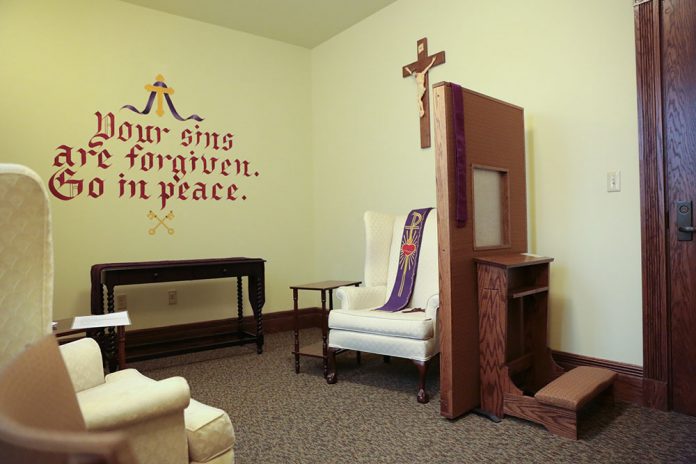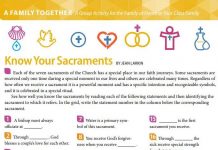
by Janet Schaeffler, Kate Ristow, Dan Thomas, Chris Weber
Why is the Eucharist sometimes called the “Holy Sacrifice of the Mass”?
Q: One of my students asked this question: Why is the Eucharist sometimes called the “Holy Sacrifice of the Mass”? It seems I should have been able to answer that easily…but frankly, I don’t know. I told her I’d find out and we’d all learn something. How would you answer that question?
—Fifth-grade catechist
Kate Ristow’s Answer
A: The index of the Catechism of the Catholic Church lists 14 names for the Eucharist. Three of the titles (the Holy Sacrifice, the Sacrifice of the Mass, and the Sacrifice of Praise) include the word sacrifice.
Our belief in the Eucharist as a sacrifice is one of the central truths of our faith. However, the “placeholder” response you gave your student was exactly correct: You did not know the answer but would find out and tell the children at your next session. In itself, your response reinforces an important truth: Religious formation is a lifelong process. There is always more to reflect on and learn about our faith no matter how old we are. So congratulations! Now, back to your question.
At the Last Supper Jesus broke bread and shared it with his disciples. He also gave them a cup of wine to share. These were very familiar rituals to the disciples; these rituals were part of the Passover meal that Jews celebrated each year. But on the night before he died, Jesus gave these actions new meaning when he said, “This is my body, which will be given for you; do this in memory of me.” And likewise the cup after they had eaten, saying, “This cup is the new covenant in my blood, which will be shed for you” (see Luke 22:19-20).
On the cross, Jesus sacrificed his life to his Father to save us from sin. When we celebrate the Eucharist, we remember and we share in the one sacrifice of Jesus. Through this great mystery, we are joined to Christ and become a living offering to God the Father. The Eucharist is a sacrifice because it makes present again Jesus’ sacrificial death on the cross.
We cannot comprehend this mystery. How can Jesus be crucified and die each time we gather for Mass? This is where faith comes in—and it is a point we must emphasize again and again with our students. We believe that we truly share the body and blood of Christ in the Eucharist, and we pray that our faith in this great mystery grows as we mature in our faith.
To help your students reflect on the mystery of the Eucharist as a Holy Sacrifice, you may want to have them work together in small groups to write prayers thanking Jesus for his sacrifice on the cross and the gift of the Eucharist. Over the next several sessions, allow time for each group to begin class by praying its prayer aloud.
Kate Ristow, Contributing Editor to CATECHIST, has worked in Catholic publishing for over 25 years as a national speaker and writer, building on a wealth of experience in the religious formation of children and catechists in both parish and Catholic school programs.
Chris Weber’s Answer
A: Christian tradition has frequently connected the saving death of Jesus to Judaism’s temple sacrifice rituals. The Letter to the Hebrews provides a striking example: “It was fitting that we should have such a high priest: holy, innocent, undefiled, separated from sinners, higher than the heavens. He has no need, as did the high priests, to offer sacrifice day after day, first for his own sins and then for those of the people; he did that once for all when he offered himself” (7:26-27).
Jesus not only sacrificed himself for us on the cross; the night before he died, he also gave us his body and blood. At every Mass, the bread and wine offered by the priest at the altar become the holy body and blood of Christ. Through the Eucharist, we become one with Christ’s sacrifice on the cross and his glorious Resurrection. Every time we gather for Mass, that Holy Sacrifice of Jesus becomes real food for us.
Remind your fifth-graders of the words of the Memorial Acclamation that we proclaim right in the middle of the Eucharistic Prayer: “When we eat this bread, and drink this cup, we proclaim your death, Lord Jesus, until you come again.”
Chris Weber has worked in the field of catechesis for over 20 years as a catechist, a parish catechetical leader, and a diocesan staff member. He is the author of Jesus-Style Recruiting: A Fresh Look at Recruiting and Forming Parish Volunteers, published by Visual Dynamics Publishing. He currently serves as Registrar at Mount St. Mary’s University in Emmitsburg, MD.
Why make the Sign of the Cross when you hear a siren?
Q: One of my students announced that her grandmother makes the Sign of the Cross every time she hears a siren or sees an ambulance go by. She wanted to know why. How would the Master Catechists have responded to this question?
—D. B.
Dan Thomas’s Answer
A: This is one of those great teaching opportunities that come up every once in awhile in the classroom. It gives the catechist a chance to respond to a genuine question with important and valuable information that interests the questioner.
The first response is to explain that making the Sign of the Cross when a siren or ambulance goes by is a way of praying for the person(s) involved in an accident or emergency and those who are responding to help. We show our concern for the stranger by this public sign. It is also a way of praying for our families, that we be preserved from danger.
Another point to talk about is the origin of the Sign of the Cross. It is one of the earliest prayers and symbols of the Church that originated in the very beginnings of the community. It is also interesting that there are differences between the Eastern and Western Churches with regard to how this sign is made.
Also, the grandmother does this publicly as an expression of her faith—something that is important to keep in mind. The Sign of the Cross is a way for us to speak symbolically to others that the cross is a part of our lives and beliefs. Praying in restaurants with the Sign of the Cross at the beginning and the end of our prayer before and after our meal is another way of witnessing to our faith.
The Sign of the Cross is also used during the Mass at several key points. We begin Mass, like nearly all of our prayers, with the Sign of the Cross. We use the small Sign of the Cross at the beginning of the Gospel reading (although this originated as the priest’s/deacon’s sign). The priest blesses the bread and wine as well as the congregation with the Sign of the Cross. A bishop makes the Sign of the Cross three times when he blesses a large group of people.
It is telling that we Christians reverence a sign that, in the time it was adopted, was a sign of a disgraceful death by a society that punished opposition. Christianity embraced that opposition because Christian values were radically different from the Roman government’s value of oppression of the poor and outcast by the powerful.
Now what do you do with all of this information? Obviously, you can’t use it all at one time, so you choose what is relevant for that moment and offer the rest at appropriate times. It is good to have information like this at your fingertips, but few of us do. Thus, it is sometimes necessary to say, “I’ll find out and let you know next class.” This is witness to our human limitations and our human gifts.
Dan Thomas served in catechetical leadership for over 30 years and remains involved in the National Conference for Catechetical Leadership (NCCL). He and his wife, Eileen, are the parents of two adult sons.
Janet Schaeffler’s Answer
A: We are grateful for our younger learners who notice these kinds of things. We are grateful for those who are curious and always ask “why?” One of the core principles of learning for all ages is that people learn best when their own questions are being answered—or explored for deeper meaning.
What your young learner has witnessed is a custom that has been adopted by many people: the ritual of praying whenever they hear a siren or see an emergency vehicle (suggesting a critical situation). Many people take that moment to pray for the people who are sick or injured or in a crisis situation as well as the medical, service, and law-enforcement personnel who are responding to the situation. As your learner’s grandmother makes the Sign of the Cross, she is pausing to pray for all those involved in the crisis.
There are many additional conversations and explorations that could flow from this question and its explanation.
For example, this could be a great time to talk with your students about prayer and our connection with others—the reality, beauty, and gift of the Communion of Saints. Often our prayers are for those people closest to us, those whom we know personally or know through our family and friends. Yet, this grandmother’s prayer reminds us that we are connected to everyone, even if we don’t know their names, even if we may never encounter them in our lives. God created us as interconnected; we are responsible for each other. Lumen gentium (“Dogmatic Constitution on the Church”), one of the core documents from the Second Vatican Council, reminds us that it has pleased God to make all people “holy and save them not merely as individuals without any mutual bonds, but by making them into a single people” (n. 9).
You might also explore with your students the many forms of prayer that we are blessed to experience within our tradition, as well as the various times and places for prayer. One way of doing this would be to focus on a different form of prayer each week. Spend a few minutes explaining the form of prayer, and then use that form of prayer at some point during your session. You might send home with students prayer ideas that their parents can incorporate into the daily lives of their families.
This question, too, is a starting point for exploring one of the continuing themes of faith formation: Everything about our faith—including our prayer—is connected to the realities of daily living.
After many years in parish and diocesan catechetical ministry, Janet Schaeffler, OP, is currently involved in catechetical/adult faith formation consultation, writing, workshops, days of reflection/retreats, and teaching. Her website is janetschaeffler.com.
Copyright 2014, Bayard, Inc. All rights reserved. This article is protected by United States copyright and other intellectual property laws and may not be reproduced, rewritten, distributed, redisseminated, transmitted, displayed, published or broadcast, directly or indirectly, in any medium without the prior written permission of Bayard, Inc.




